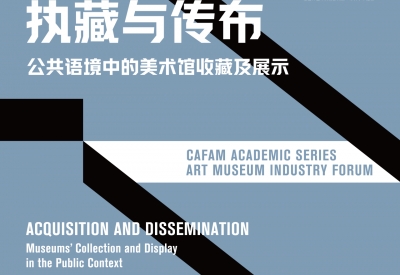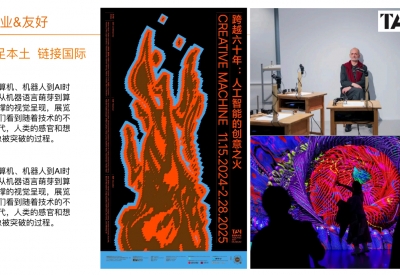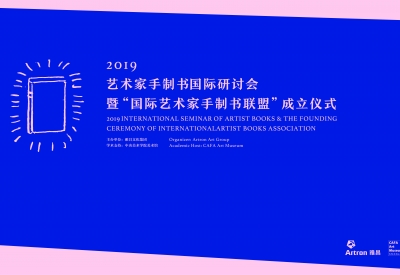2018-11-06
29798 read
On November 3, the second day of “International Art Education Conference Art Museum Forum: Opportunities and Challenges of Art Museums in the Digital Age” was transferred to the conference hall of the Ovation Seven-Cultivation Hotel in Langfang. The discussion on that day started with “The Role of Art Museums in Making the Contemporary Art History” and “The Differences Between Public and University Art Museums in Art Education”.Session II: The Role of Art Museums in Making the Contemporary Art HistoryTime: 10:30-12:30, Saturday, November 3, 2018Venue: The Conference Hall of Ovation Seven-Cultivation Hotel in LangfangHost: Gao Gao, Assistant to Director, CAFA Art MuseumChairs of Forum: Zhang Zikang, Director of CAFA Art Museum Geoffrey Ward, Acting Director of Fitzwilliam Museum, Deputy Vice-Chancellor of University of CambridgeGuests: John W. Smith, Adele Tan, Jiyoon Lee, Ji Shaofeng, Hang Jian, Li Xiaoshan, Wang Chunchen (list in the order of speech)1John W. Smith, Director of Museum of Rhode Island School of DesignJohn W. Smith, Director of Museum of Rhode Island School of Design, made a speech on “A Museum for Artists-Its Past and Future”. He combined with the background of Rhode Island School of Design and shared the experience of how the museum develops around teaching. Rhode Island was once the textile center and important jewelry industry with a long history in design. The 140-year-old Rhode Island School of Design still uses the ancient technique of copying as one of the means of art education, and the Museum of Rhode Island School of Design is the main site for students to copy famous paintings. The museum is closely related to the study and practice of students, as they are deeply involved in public education, exhibition curating and collection management.2Adele Tan, Senior Curator of National Gallery SingaporeAdele Tan, Senior Curator of National Gallery Singapore, spoke on “Making Space: the Digital World and the Art Museum”. Curator Chen is in charge of the museum’s collection and exhibition since the 1970s, as well as entrusted projects of contemporary works. She first talked about the development and reform of the National Gallery Singapore, including the influence of the two performance arts “32 Years: The Interrogation of a Mirror” and “Let’s Walk Together” on the museum and contemporary art in Singapore. Another major part of Curator Chen’s speech was the museum’s attempts based on the characteristics of the digital age, such as developing online exhibitions on mobile apps, exhibitions based on twitter, design exhibitions of pure electronic version that exists on the web, and digital interactive “social desktop” where exhibits can be viewed online. The National Gallery Singapore has tried to make use of digital technology to create many virtual exhibitions on the digital platform and made them become a beneficial supplement to the physical displays.3Jiyoon Lee, Former Managing Director at National Museum of Modern and Contemporary Art (MMCA), Korea; Director of SUUM Contemporary Art ProjectJiyoon Lee, Former Managing Director at MMCA, Korea and Director of SUUM Contemporary Art Project, gave a speech on “The Role of Curatorship in the Age of New Technology Art”. Based on her own experience in the construction and curation of the museum, Director Lee primarily introduced how to use new technology to intervene in this process. The MMCA, Korea has been trying to develop art based on new technologies. It receives the technical support from high-tech enterprises such as Hyundai Motor and Hyundai Engine – they incorporate technology into artistic creation and art exhibition to create more possibilities for the museum. At the same time, Director Lee also stressed to help the curators to obtain opportunities for multi-dimensional learning and practice, because curators are not only researchers but also project managers, creators and producers.4JI Shaofeng, Director of Hubei Museum of ArtJI Shaofeng, Director of Hubei Museum of Art, talked about “Collecting is Thinking: the Role of Art Museums in Contemporary Art History”. Director Ji believes that collecting should be a forward-looking study and collection of works in line with and beyond the times, so as to preserve the most valuable thoughts through collecting. When these thoughts are implemented in art museums, they will play an active role in the development, construction and research of contemporary art history. In the study of modern art history, we should avoid the interference of power and the bondage of capital, construct the collection series of contemporary art history from the perspective of art history and promote the construction of contemporary art history with the collection.5 HANG Jian, Director-General of CAA Museum, China Academy of ArtHANG Jian, Director-General of CAA Museum, China Academy of Art, delivered a speech on “The History of Design and the Design Museum in China – A Process of Designing Democratic Value Discovery”. Director Hang first introduced the three parts constituting the art museum group of China Academy of Art: the Museum of Contemporary Art, China Design Museum and China Academy of Arts' Folk Art Museum. Among them, he highlighted the planning concept and the eye-catching exhibition of the China Design Museum that just opened on April 8 this year. Director Hang pointed out that the mission of the China Design Museum is to consider how to respond to the changes in society and science & technology. In today’s rapidly changing science and technology, compared with art museums, China Design Museum pays more attention to the relationship between technology and human life in the future development, as well as the impact of technology on human future.6Li Xiaoshan, Director of Art Museum of Nanjing University of the ArtLi Xiaoshan, Director of Art Museum of Nanjing University of the Art, spoke on the topic of “From the Art Museum of Nanjing University of the Art to See the Present Situation and Future of Efficient Art Museums in China”. After a brief introduction of the art museum, he put forward three problems: the boundary of the art museum, the standards and features of the art museum, and opportunities and challenges of art museums in the digital age, which are three topics that currently faced by many art museums and deserves pondering. Director Li believes that the discussion of the forum should not focus on the explanation of each museum but to go deep into the consideration of practical problems such as theoretical problem, conceptual problem, and standard features of managing art museums, and so on.7WANG Chunchen, Deputy Director of CAFA Art MuseumWANG Chunchen, Deputy Director of CAFA Art Museum, made a speech on the topic of “Art Museum and the Making of Art History”. Director Wang stated that art museums appeared with the birth of art history research and played a critical role in the making of art history. Art Museums should undertake the recording and studying of art history, rather than just turning museum space into places for public activities, even sites for recreation and capital consumption. At the end of his speech, Director Wang hopes that peers of art museums can clarify the responsibilities of the art museum and make today’s art museums regain their mission of constructing art history. When the speeches of the second session were finished, two chairs of forum discussed with speakers and on-site media on issues such as art museum and contemporary art, art museum’s role of making art history, the specialty of design and architecture museums, etc. For art museums and contemporary art, Geoffrey Ward pointed out that there is a paradox between art museums and contemporary art as some art museums become boxes for hanging paintings and this kind of simple arrangement is a common problem of modern art museums. Regarding the art museum and art history, Director Smith thinks that the more important work of curators is not to write the history of art but to build a narrative belonging to the institution itself. Successful curators can tell a grand story in low-cost and express the whole trend through a certain aspect. As for the particularity of design museums, Director Hang states that the mission of art exhibition is different from that of contemporary design exhibition. The former helps to observe objects in different chains of design history, technological and social development, while the latter points to the possibility of future life. In response to the media’s questions about the acceptance of architectural exhibitions, Director Lee said that the MMCA Korea has already paid attention to the importance of collecting architectural models and started planning the exhibition of architects. Last year, the Seoul Biennale of Architecture was held in Seoul, and more architectural exhibitions will be held in the art museum in the future. Director Hang said that when the China Design Museum just opened, it took one third of the exhibition space to make the first Asian architecture exhibition for Siza, and it tried to think about the development of Chinese architecture itself by sorting out the development history of important international architects along with the different possibilities of their works around the world.Session III: The Differences Between Public and University Art Museums in Art EducationTime: 14:00-18:00, Saturday, November 3, 2018Venue: The Conference Hall of Ovation Seven-Cultivation Hotel in LangfangHost: Wang Chunchen, Deputy Director of CAFA Art MuseumGuests: Uladzimir Prakaptso, Geoffrey Ward, Ernst Vegelin van Claerbergen, Caitlin Doherty, Zhou Xujun, Patricia Rodewald, Guillermo Solana, Cao Hong, Meng Xianwei, Han Haiyan (list in the order of speech)1Uladzimir Prakaptso, Chairman of Belarusian Art Society, Director of National Art Museum of the Republic of BelarusUladzimir Prakaptso, Chairman of Belarusian Art Society, Director of National Art Museum of the Republic of Belarus, started the forum with the topic of “Cultural Cooperation is an Integral Component of the Belarusian-Chinese Relations”. He briefly introduced the “The Belt and Road” cooperation between Belarus and China. Prakaptso believes Chinese art is very attractive to the National Art Museum of the Republic of Belarus and hopes to bring more works of Chinese artists into Belarus. He also mentioned that 2019 is the 80th anniversary of the establishment of the art museum, which he hopes to witness with the participating guests together.2Geoffrey Ward, Acting Director of Fitzwilliam Museum, Deputy Vice-Chancellor of University of CambridgeGeoffrey Ward, Acting Director of Fitzwilliam Museum, Deputy Vice-Chancellor of University of Cambridge, spoke on “The Differences between Public and University Art Museums”. Director Ward first described the differences between Western and Chinese museums. He mentioned that, in the context of his work, in addition to a strong artistic background and successful management experience, museum directors are required to have the ability to raise funds, extensive contacts and business planning capability, as well as enough confidence to deal with the relationship between the 800-year-old university and the young art museum. He also stated in detail the difficulties faced in Britain, such as the increasing involvement of the government in the management but the reluctance to provide financial support, and the fact that charity is often an essential resource of funding for museums. Ward concluded that the function of a university museum is to stimulate students’ interest in art while serving as a link connecting different social groups.3Ernst Vegelin van Claerbergen, Director of the Courtauld GalleryErnst Vegelin van Claerbergen, Director of the Courtauld Gallery, made a speech on “The Public Value of the University Art Museum”. He believes that the university art museum should be a cutting-edge existence, and instead of letting people learn what they already know, it should expand the public’s knowledge in this field and promote the democratization of knowledge. University art museums and museums are supposed to be confident in dealing with factors from different aspects. At the same time, he also raised doubts about using the number of visitors as the standard to evaluate an art museum. He believes that organizing a well-received exhibition by such a criterion might deprive the audience of opportunities to learn about other art forms.4Caitlin Doherty, Executive Director of Museum of Contemporary Art Jacksonville, University of North FloridaCaitlin Doherty, Executive Director of Museum of Contemporary Art Jacksonville, University of North Florida, gave a speech on “MOCA Jacksonville: A Bridge Between Campus and Community”. Director Doherty believes that art and culture are a driving force, not a mere superstructure, that should undertake more responsibility for the community. By introducing different exhibition planning projects, she elaborated the museum’s attempt to change students’ lives through education projects and stressed that in this respect, the art museum plays an increasingly significant role and will help more community members to accept art education.5ZHOU Xujun, Director of Minsheng Art Museum BeijngZHOU Xujun, Director of Minsheng Art Museum Beijng, made a speech on “Public Art Museum and Art Education for the Public: the Case of Minsheng Art Museum”. Director Zhou believes that in the information age when visual images are easily accessible, art museums’ role of public education is changing and are endowed with the function of “knowledge production” and “social intercourse space”. As a model of private Chinese contemporary art museum, the three-year-old Minsheng Art Museum Beijing attaches great importance to public education, adhere to the idea of “equality and openness” and emphasize the connection with the urban public. From five keywords of “exhibition”, “children”, “cross-field”, “theory” and “public”, the museum designs and builds brand public education activities, making the art museum a cultural exchange platform for multiple services and constantly inject new cultural energy for the city.6Patricia Rodewald, Senior Advisor for Global Programs (China) of American Alliance of MuseumsPatricia Rodewald, Senior Advisor for Global Programs (China) of American Alliance of Museums, talked about “Artificial Intelligence and Interpretation: Engaging Audiences in New Ways”. Rodewald said that she and her team serve non-professionals and hope to encourage this kind of group to appreciate and explore artworks at close range. For that reason, they actively exploit different ways of interacting with the audience from traditional museums, such as developing some AI technologies to help the viewer conduct a direct dialogue with the collection, as it will be a very meaningful experience for the audience.7Guillermo Solana, Artistic Director of Museo Thyssen-BornemiszaGuillermo Solana, Artistic Director of Museo Thyssen-Bornemisza, gave a speech about “Artists’ Workshops as an Educational Tool: The Case of the Thyssen Museum, Madrid, Spain”. In his talk, he said that early European museums were important places for educating artists, but now, the relationship between art museums and contemporary artists becomes alienated. He has been considering the relationship between artists and art museums, and how to make the public re-recognize this relationship. Based on this thought, the art museum holds an in-depth exhibition of contemporary artists every year. Apart from guiding visitors to appreciate works, artists also invite them to participate in the exhibition so that visitors can understand the creation process of contemporary artists and the production process of works in the museum.8CAO Hong, Deputy Director of Arthur M. Sackler Museum of Art and Archeology at Peking UniversityCAO Hong, Deputy Director of Arthur M. Sackler Museum of Art and Archeology at Peking University, delivered a speech entitled “The Role of University Art Museum in the Higher Education of Arts: A Case of Arthur M. Sackler Museum at Peking University”. Director Cao introduced the museum’s three types of exhibitions: exhibitions showing the newest archaeological discoveries and scientific research results, art exhibitions emphasizing a dialogue between ancient and modern times, innovative exhibitions planned and made by students. These kinds of exhibitions aim to develop a relationship with the students using the collection and offer them maximum privileges to engage in the collection sorting and studying.9MENG Xianwei, Founder of "Qingdao Artists' Garden" Project, Director-general of Qingdao Museum of Contemporary ArtMENG Xianwei, Founder of "Qingdao Artists' Garden" Project, Director-general of Qingdao Museum of Contemporary Art, spoke on the topic of “Construction and Ecology Establishment of Qingdao Museum of Contemporary Art”. In his speech, Meng stated the design concept and plan of the art museum – an art museum that is closely related to art and life. As a cultural facility of the city, he expects the art museum can make contributions to nature and community, and thus integrate into the natural environment.10HAN Haiyan, Deputy Director of Langfang Gallery of CAFA Art MuseumHAN Haiyan, Deputy Director of Langfang Gallery of CAFA Art Museum, gave a speech on “Come-in Visitors, Go-out Art Museums - Unlimited Growing Public Education”. Director Han introduced the specific circumstance of the project of the “International Cultural Exchange Center of the Silk Road” in Langfang, followed by a series of art education projects launched to promote the connection between art and the public. She also analyzed the challenges the museum may face in its future operation.After the keynote speeches finished, two chairs of forum exchanged opinions with speakers and on-site guests on issues such as using the number of visitors as the standard to evaluate an art museum. James Bradburne said that with different aims and missions, art museums do need to have some conventional measuring factors as the standard of assessing an art museum but the number of visitors does not mean anything, and it probably makes more sense to give a more detailed analysis, like to analyze how many visitors are repeat visitors or first-time visitors and what is the proportion of young people or children. Director Doherty believes that exhibition space should be a place for experimentation so that the art museum should go back to explore more demands and possibilities of visitors beyond the statistical framework. Director Zhang Zikang stated that the quality and quantity of the audience should be taken into consideration to promote good exhibitions and valuable arts.At this point, the two-day “International Art Education Conference Art Museum Forum: Opportunities and Challenges for Art Museums in the Digital Age” ended completely. However, art museum practitioners will continue to question and think about issues of current value and future development of art museums as well as how should today’s art museums respond to the changes of the times. The answer is open and dynamic, which requires more diversified art museum practices to inspire new creativity and imagination space.
More








